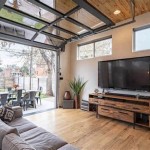Tree In The Living Room
Are you looking for atypical design ideas and want to integrate more nature into your living space? If so, consider bringing a real tree into your living room. A tree in the living room is an eye-catching element that creates a unique and inviting ambiance. It can transform your living room into a green oasis, improving your well-being and connecting you with nature.
Before embarking on this project, there are several factors to consider to ensure the health and longevity of your indoor tree. The first step is choosing the right tree species. Not all trees are suitable for indoor living conditions. Look for trees that are known for their adaptability and tolerance to indoor environments. Some popular choices include the fiddle-leaf fig, snake plant, ZZ plant, and peace lily.
Once you have chosen your tree, you need to provide it with the proper care. Indoor trees require specific light, water, and humidity levels to thrive. Determine the ideal placement for your tree based on its light requirements. Most indoor trees prefer bright, indirect light, but some can tolerate low light conditions. Avoid placing your tree in direct sunlight, as this can scorch its leaves.
Watering your indoor tree is crucial, but overwatering is a common mistake. Allow the top inch of soil to dry out before watering again. The frequency of watering will vary depending on the type of tree, the size of the pot, and the temperature and humidity of your living space. Use lukewarm water and avoid getting water on the leaves, as this can promote disease.
Maintaining proper humidity levels is also essential for indoor trees. Dry air can cause leaves to brown and drop. To increase humidity, you can use a humidifier, place your tree on a pebble tray filled with water, or group it with other plants.
Fertilizing your indoor tree regularly will provide it with the nutrients it needs to grow and stay healthy. Use a balanced liquid fertilizer diluted to half strength during the growing season. Avoid over-fertilizing, as this can damage the roots.
Repotting your indoor tree is necessary as it grows. Choose a pot that is slightly larger than the current one and has drainage holes. Use a well-draining potting mix specifically designed for indoor plants. Repotting should be done in the spring or summer when the tree is actively growing.
In conclusion, bringing a tree into your living room can create a unique and inviting space while improving your well-being. By choosing the right tree species, providing proper care, and addressing its specific needs, you can enjoy the beauty and benefits of nature within the comfort of your own home.

Crushing On Large Indoor Trees Stacy Risenmay

Pin Page

Diy Faux Real Indoor Tree Jenna Sue Design

20 Best Indoor Trees For Every Kind Of Plant Parent

When The Greenery Goes A Lil Crazy That S Good Thing Designed

Living Room With Potted Tree Transitional

20 Best Indoor Trees For Every Kind Of Plant Parent
How To Choose The Right Sized Artificial Tree And Plant Ly Natural

Diy Faux Real Indoor Tree Jenna Sue Design

How To Make A Stunning Diy Faux Tree That Looks Real








